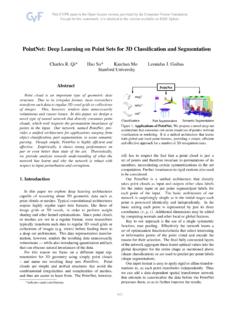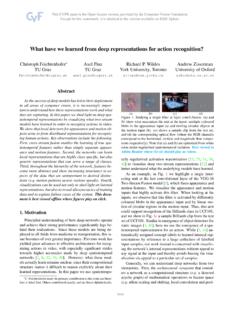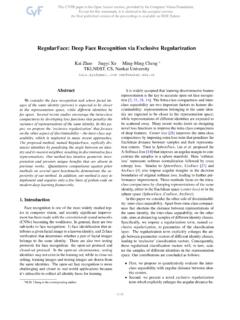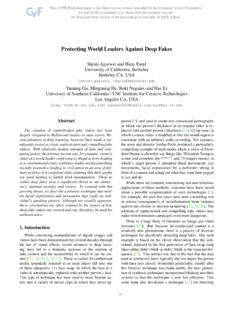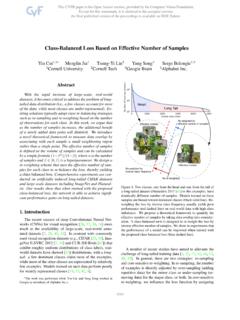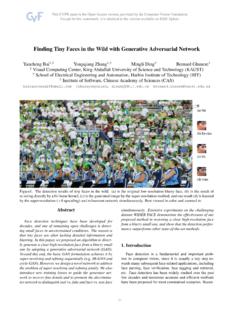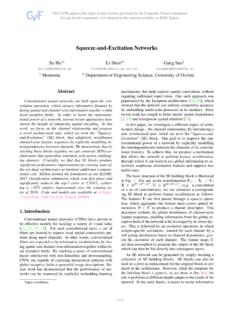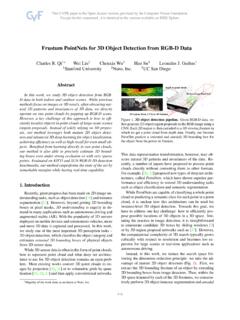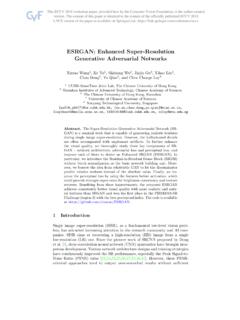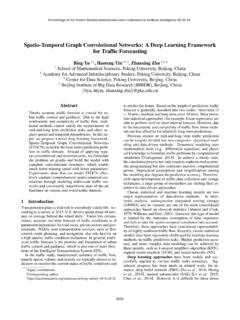Transcription of Point-GNN: Graph Neural Network for 3D Object Detection in ...
1 Point-GNN: Graph Neural Network for 3D Object Detection in a Point CloudWeijing Shi and Ragunathan (Raj) RajkumarCarnegie Mellon UniversityPittsburgh, PA 15213{weijings, this paper, we propose a Graph Neural Network todetect objects from a LiDAR point cloud. Towards thisend, we encode the point cloud efficiently in a fixed ra-dius near-neighbors Graph . We design a Graph Neural net-work, named Point-GNN, to predict the category and shapeof the Object that each vertex in the Graph belongs to. InPoint-GNN, we propose an auto-registration mechanism toreduce translation variance, and also design a box merg-ing and scoring operation to combine detections from mul-tiple vertices accurately. Our experiments on the KITTI benchmark show the proposed approach achieves leadingaccuracy using the point cloud alone and can even sur-pass fusion-based algorithms. Our results demonstrate thepotential of using the Graph Neural Network as a new ap-proach for 3D Object Detection .}
2 The code is available IntroductionUnderstanding the 3D environment is vital in robotic per-ception. A point cloud that composes a set of points in spaceis a widely-used format for 3D sensors such as LiDAR. De-tecting objects accurately from a point cloud is crucial inapplications such as autonomous Neural networks that detect objects fromimages rely on the convolution operation. While the con-volution operation is efficient, it requires a regular grid asinput. Unlike an image, a point cloud is typically sparse andnot spaced evenly on a regular grid. Placing a point cloud ona regular grid generates an uneven number of points in thegrid cells. Applying the same convolution operation on sucha grid leads to potential information loss in the crowdedcells or wasted computation in the empty breakthroughs in using Neural networks [3] [22]allow an unordered set of points as input. Studies takeadvantage of this type of Neural Network to extract pointcloud features without mapping the point cloud to a , they typically need to sample and group pointsFigure 1.
3 Three point cloud representations and their common pro-cessing to create apoint setrepresentation. The re-peated grouping and sampling on a large point cloud canbe computationally costly. Recent 3D Detection approaches[10][21][16] often take a hybrid approach to use a grid anda set representation in different stages. Although they showsome promising results, such hybrid strategies may sufferthe shortcomings of both this work, we propose to use a Graph as a compactrepresentation of a point cloud and design a Graph neuralnetwork called Point-GNN to detect objects. We encodethe point cloud natively in a Graph by using the points as thegraph vertices. The edges of the Graph connect neighbor-hood points that lie within a fixed radius, which allows fea-ture information to flow between neighbors. Such a graphrepresentation adapts to the structure of a point cloud di-rectly without the need to make it regular. A Graph neuralnetwork reuses the Graph edges in every layer, and avoidsgrouping and sampling the points [15] [9] [2] [17] have looked into using graphneural Network for the classification and the semantic seg-mentation of a point cloud.
4 However, little research haslooked into using a Graph Neural Network for the 3D objectdetection in a point cloud. Our work demonstrates the fea-sibility of using a GNN for highly accurate Object detectionin a point proposed Graph Neural Network Point-GNN takesthe point Graph as its input. It outputs the category andbounding boxes of the objects to which each vertex be-longs. Point-GNN is a one-stage Detection method that de-tects multiple objects in a single shot. To reduce the trans-lation variance in a Graph Neural Network , we introduce an1711auto-registration mechanism which allows points to aligntheir coordinates based on their features. We further designa box merging and scoring operation to combine detectionresults from multiple vertices evaluate the proposed method on the KITTI bench-mark. On the KITTI benchmark, Point-GNN achieves thestate-of-the-art accuracy using the point cloud alone andeven surpasses sensor fusion approaches.
5 Our Point-GNNshows the potential of a new type 3D Object Detection ap-proach using Graph Neural Network , and it can serve as agood baseline for the future research. We conduct an exten-sive ablation study on the effectiveness of the componentsin summery, the contributions of this paper are: We propose a new Object Detection approach usinggraph Neural Network on the point cloud. We design Point-GNN, a Graph Neural Network with anauto-registration mechanism that detects multiple ob-jects in a single shot. We achieve state-of-the-art 3D Object Detection accu-racy in the KITTI benchmark and analyze the effec-tiveness of each component in Related WorkPrior work in this context can be grouped into three cat-egories, as shown in cloud in recent studies convert a pointcloud to a regular grid to utilize convolutional Neural net-works. [20] projects a point cloud to a 2D Bird s Eye View(BEV) image and uses a 2D CNN for Object Detection .
6 [4]projects a point cloud to both a BEV image and a FrontView (FV) image before applying a 2D CNN on both. Suchprojection induces a quantization error due to the limitedimage resolution. Some approaches keep a point cloud in3D coordinates. [23] represents points in 3D voxels and ap-plies 3D convolution for Object Detection . When the resolu-tion of the voxels grows, the computation cost of 3D CNNgrows cubically, but many voxels are empty due to pointsparsity. Optimizations such as the sparse convolution [19]reduce the computation cost. Converting a point cloud to a2D/3D grid suffers from the mismatch between the irregulardistribution of points and the regular structure of the cloud in learning techniques on sets suchas PointNet [3] and DeepSet[22] show Neural networks canextract features from an unordered set of points directly. Insuch a method, each point is processed by a multi-layer per-ceptron (MLP) to obtain a point feature vector.
7 Those fea-tures are aggregated by an average or max pooling functionto form a global feature vector of the whole set. [14] furtherproposes the hierarchical aggregation of point features, andgenerates local subsets of points by sampling around somekey points. The features of those subsets are then againgrouped into sets for further feature extraction. Many 3 Dobject Detection approaches take advantage of such neuralnetworks to process a point cloud without mapping it to agrid. However, the sampling and grouping of points on alarge scale lead to additional computational costs. Most ob-ject Detection studies only use the Neural Network on setsas a part of the pipeline. [13] generates Object proposalsfrom camera images and uses [14] to separate points that be-long to an Object from the background and predict a bound-ing box. [16] uses [14] as a backbone Network to generatebounding box proposals directly from a point cloud. Then,it uses a second-stage point Network to refine the bound-ing boxes.
8 Hybrid approaches such as [23] [19] [10] [21]use [3] to extract features from local point sets and placethe features on a regular grid for the convolutional opera-tion. Although they reduce the local irregularity of the pointcloud to some degree, they still suffer the mismatch betweena regular grid and the overall point cloud cloud in on Graph Neural Network [18] seeks to generalize the convolutional Neural Network toa Graph representation. A GNN iteratively updates its vertexfeatures by aggregating features along the edges. Althoughthe aggregation scheme sometimes is similar to that in deeplearning on sets, a GNN allows more complex features tobe determined along the edges. It typically does not needto sample and group vertices repeatedly. In the computervision domain, a few approaches represent the point cloudas a Graph . [15] uses a recurrent GNN for the semanticsegmentation on RGBD data. [9] partitions a point cloud tosimple geometrical shapes and link them into a Graph for se-mantic segmentation.
9 [2] [17] look into classifying a pointcloud using a GNN. So far, few investigations have lookedinto designing a Graph Neural Network for Object Detection ,where an explicit prediction of the Object shape is work differs from previous work by designing aGNN for Object Detection . Instead of converting a pointcloud to a regular gird, such as an image or a voxel, weuse a Graph representation to preserve the irregularity of apoint cloud. Unlike the techniques that sample and groupthe points into sets repeatedly, we construct the proposed Point-GNN then extracts features of the pointcloud by iteratively updating vertex features on the samegraph. Our work is a single-stage Detection method with-out the need to develop a second-stage refinement neuralnetworks like those in [4][16][21][11][13].3. Point-GNN for 3D Object Detection in aPoint CloudIn this section, we describe the proposed approach to de-tect 3D objects from a point cloud.
10 As shown in Figure2,the overall architecture of our method contains three com-ponents: (a) Graph construction, (b) a GNN ofTiterations,1712 Figure 2. The architecture of the proposed approach. It has three main components: (a) Graph construction from a point cloud, (b) a graphneural Network for Object Detection , and (c) bounding box merging and (c) bounding box merging and Graph ConstructionFormally, we define a point cloud ofNpoints as a setP={p1, .., pN}, wherepi= (xi, si)is a point with both3D coordinatesxi R3and the state valuesi Rkak-length vector that represents the point property. The statevaluesican be the reflected laser intensity or the featureswhich encode the surrounding objects. Given a point cloudP, we construct a graphG= (P, E)by usingPas the ver-tices and connecting a point to its neighbors within a fixedradiusr, {(pi, pj)|kxi xjk2< r}(1)The construction of such a Graph is the well-known fixedradius near-neighbors search problem.

